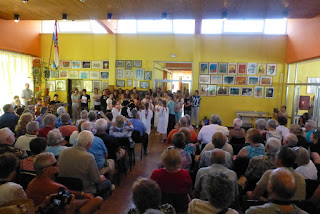Fri. June 12--Vukovar-Osijek, Croatia: We arrived in Vukovar soon after breakfast.
Alina was worried about Customs Officials and told us to expect some demands
for face/passport matching but as it turned out we weren't held up at all.
Vukovar was heavily damaged in the Homeland War, as was 2/3 of Croatia, and
what buildings remain are either pockmarked with bullet holes, or gutted and empty, or have newly plastered and painted facades. The large water tower in
town is still standing and hasn't been repaired, serving as a memorial to the
many people who died. In this highly depressed country rebuilding is happening
very slowly and low birthrate and "brain drain" is resulting in
population drops and small villages. We only passed through Vukovar on buses to
get to Osijek, on the Drava River that enters the Danube up river from Vukovar.
The drive through the countryside was very nice with acres of farmland growing
corn, sunflowers, soybeans and other crops. In old Osijek there is a huge
fortification that was built in the 17th century by the Habsburgs to keep out
the Ottomans and protect the rest of the huge Christian Kingdom from falling.
It was large enough to hold houses, a monastery, shops, several streets, businesses;
everything needed to live for years, if necessary. The walls along the Danube
remain but as the village grew the other walls were taken down to allow growth.
During the Homeland War people from nearby villages moved into the
fortification in Osijek and lived there again for as long as 6 years when so
much of the country was destroyed (partly to punish Croatia for siding with
Hitler, partly by Serbia to retaliate for how Orthodox Serbs were treated in
Roman Catholic Croatia. Ethnic cleansing happened on both sides and it is hard
to imagine the animosity between two so closely tied societies.) Most Croatians
now are trying to forgive, forget and move on but as our guide told us
"misunderstandings" remain, especially among older people.
 |
| Leaving Vukovar |
 |
| Our guide for the old walled part of Osijek |
 |
| 16th century buildings now used by a university |
 |
| Memorial statue for the Croatian Jews |
 |
| Gate into the walled city |
 |
| Fortifications on the river side of old Osijek |
In Osijek,
too, we saw many buildings riddled with bullet holes. The buses took us to a
nearby primary (7-14 years old) school called Dobrisa Cesaric (for a Croatian
poet) where the award winning choir put on a wonderful performance for us.
We
were then taken to a small village and broken into groups of 7-10 people and we
were served a home cooked meal. Our group ate with a family of 4 in an open air
brick gazebo in the side yard of the house. The man works for a local winery
and also makes wine at home and the woman is a baker for the local hospital. We
enjoyed their homemade plum brandy, cherry liquor, and wine, and the meal made
with home grown vegetables and fruits while we chatted with the family and
learned about their life in Croatia. It was another 91 degree sunny day but it
was very pleasant to sit and enjoy the breeze and the home of these folks.
 |
| Our guide and the hosts with the house in the background |
 |
| Our lunch hosts, minus the 6 year old boy who mostly avoided us |
 |
| Peggy tries the plum brandy before the meal |
 |
The gazebo where we ate lunch. Note the roses climbing
the posts on each side and spreading across the entrance. |
It
was about half an hour ride back to the ship where we relaxed and had a lecture
on Croatian history in the lounge. The evening entertainment was a combo called
the "No Jazz Band" playing mostly American standards. I listened from
the library and worked on the blog until my battery died and then finished in
the room as the ship set sail for Hungary.
 |
| Leaving Croatia |













No comments:
Post a Comment